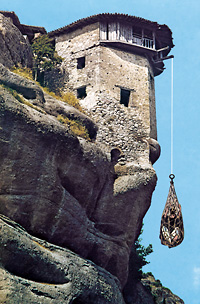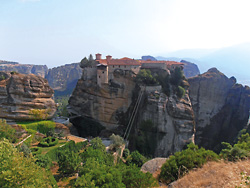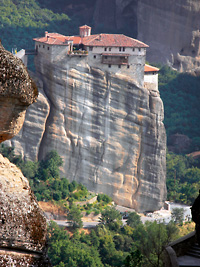Pilgrimages
RELIGIOUS TOURISM: THE METEORA, ONE OF THE MOST ATTRACTIVE DESTINATIONS OF RELIGIOUS TOURISM IN GREECE
The Monastic City on Rocks
An ascetic life began here in 985, with the arrival of monk Barnabas. After establishing Dupjana, the first monastery, and Protat church, the establishment of monastic fraternities began in the 11th century. The renaissance of the Meteora, in the 14th century, is linked with the arrival of a Holy Mountain monk Athanasius, the founder of the Great Meteora and the creator of the first Meteora Typicon, but also with despot Simeon (the son of Serbian king Stefan Dečanski), and his successor Jovan Uroš, with monastic name of Joasaf, whose support was immeasurable
By: Mišo Vujović
 Approaching the tourist town of Kalambaka, you are greeted by a fascinating scene of ”unearthly” rocks with monumental monastery buildings standing on their peaks, like mushrooms. Approaching the tourist town of Kalambaka, you are greeted by a fascinating scene of ”unearthly” rocks with monumental monastery buildings standing on their peaks, like mushrooms.
In the narrow streets of Kalambaka it is difficult top find a parking place, and it is almost impossible not to bump into tourists and pilgrims from various parts of Serbia. A large number of taverns, restaurants, pizzerias, buffets offer, at reasonable price, various specialties of Greek and international cuisine, and in the vicinity of Kalambaka there are several large parking areas and excellently equipped auto camps.
A winding road through a picturesque village of Kastraki, nestled between huge pedestals, made by the hands of the creator, leads to an elevation from which there is a beautiful view of Kalambaka and fertile Thessaly plains. In nearby elevations and rocks, groups of tourists are taking positions for sightseeing and taking photographs, a mixture of different languages and dialects can be heard. Jolly murmur of thrilled tourists and pilgrims is mixed with monastic chanting coming from the nearby cliff, and one of the monastery buildings.
”A unique view of the rocks surrounded by a green carpet, creates a sense of admiration mixed with awe, but at the same time joy and excitement, because it is exactly from the peaks of these mountains that one feels all of their weakness toward the work of the creator. At the same moment, the sense of greatness and beauty is born. And this beauty is expressed through moderation. Its content and form are in full harmony.(...) The feeling of greatness is born from looking at these high rocks, on the peaks of which you are standing, and it seems as if you are somewhere between the earth and the sky. Spotting the green valley, you will encounter the ideal balance, and you are imbued with Olympic peace while watching this masterpiece of nature...”, wrote Teoharis Provatakis, chronicler and a devotee of this masterpiece of nature and human entrepreneurship.
After the development of tourism as the leading industry of Greece, the new era of the Meteora has commenced, this unique monastic town between heaven and earth. Today certainly one of the most attractive destinations of the ancient Ellada.
FOLLOWING THE FOOTSTEPS OF THE HOLY NEMANJIĆ DYNASTY
 Modeled after the Holy Mountain monkhood, the monastery complex of Meteora was established in the early 11th century. Historians write that the beginning of monastic life here dates back to 985 and the coming of monk Barnabas. It was at that time that the first monastic cells were made in the caves of inaccessible rocks. With the first monastery Dupjani and Protat Church were built in the 11th century, the establishment of monastic fraternity began. More intense ascetic life on the Meteora begins in the 14th century, when monk Athanasius from the Holy Mountain built the Great Meteora on one of the highest rocks, 623 meters high. He named it Meteoro, and dedicated it to the Transfiguration of Christ. Modeled after the Holy Mountain ascetics, the founder of the Great Meteora issued the first Typicon (monastic rule), which still regulates the monastic life on the Meteora today. The first fraternity was comprised of 14 monks, and the monastery had great privileges of despot Simeon, the ruler of Aetolia, half-brother of Serbian king Stefan Dušan. After Dušan’s death, Simeon unites Thessaly and Epirus, proclaiming himself first the king, and then the emperor. He will be remembered as the great founder and benefactor of the entire monastic community on the Meteora. His successor, a Holy Mountain student, John Ouresis Doukas Palaiologos, enchanted by the ethical and ascetic image of monk Athanasius, continues to support Athanasius and his fraternity, which strengthens the influence of the community and is regarded as the golden era of the Meteora. Following ascetic examples of the holy Nemanjić dynasty, led by desire for eternal wisdom, John Ouresis Doukas Palaiologos renounces earthly riches and his earthly treasures and exchanges the power for monastic cope, becoming the humble monk Joasaf, after the death of his monastic brother and friend Athanasius, and the abbot of the Great Meteora. Modeled after the Holy Mountain monkhood, the monastery complex of Meteora was established in the early 11th century. Historians write that the beginning of monastic life here dates back to 985 and the coming of monk Barnabas. It was at that time that the first monastic cells were made in the caves of inaccessible rocks. With the first monastery Dupjani and Protat Church were built in the 11th century, the establishment of monastic fraternity began. More intense ascetic life on the Meteora begins in the 14th century, when monk Athanasius from the Holy Mountain built the Great Meteora on one of the highest rocks, 623 meters high. He named it Meteoro, and dedicated it to the Transfiguration of Christ. Modeled after the Holy Mountain ascetics, the founder of the Great Meteora issued the first Typicon (monastic rule), which still regulates the monastic life on the Meteora today. The first fraternity was comprised of 14 monks, and the monastery had great privileges of despot Simeon, the ruler of Aetolia, half-brother of Serbian king Stefan Dušan. After Dušan’s death, Simeon unites Thessaly and Epirus, proclaiming himself first the king, and then the emperor. He will be remembered as the great founder and benefactor of the entire monastic community on the Meteora. His successor, a Holy Mountain student, John Ouresis Doukas Palaiologos, enchanted by the ethical and ascetic image of monk Athanasius, continues to support Athanasius and his fraternity, which strengthens the influence of the community and is regarded as the golden era of the Meteora. Following ascetic examples of the holy Nemanjić dynasty, led by desire for eternal wisdom, John Ouresis Doukas Palaiologos renounces earthly riches and his earthly treasures and exchanges the power for monastic cope, becoming the humble monk Joasaf, after the death of his monastic brother and friend Athanasius, and the abbot of the Great Meteora.
MATERIAL COLLECTED FOR 70 YEARS
 The entire complex is dominated by the three-nave Church of the Transfiguration of Christ, with inscribed cross, three domes and lateral apses. The temple is situated in the central part, 2 meters long and 24 meters high, consists of the external narthex, narthex of the main temple, and is considered one of the most beautiful buildings of the third period of Byzantine architecture. The building of the church was commenced by the holy Athanasius, and was completed by holy Joasaf. Around 1552, the temple was decorated with frescos, during the time of abbot Simeon, while the dominant element of the interior are the imperial doors with gold plated wooden iconostasis that resembles the monasteries of the Holy Mountain Athos. The following inscription is engraved in the eastern part of the temple: The entire complex is dominated by the three-nave Church of the Transfiguration of Christ, with inscribed cross, three domes and lateral apses. The temple is situated in the central part, 2 meters long and 24 meters high, consists of the external narthex, narthex of the main temple, and is considered one of the most beautiful buildings of the third period of Byzantine architecture. The building of the church was commenced by the holy Athanasius, and was completed by holy Joasaf. Around 1552, the temple was decorated with frescos, during the time of abbot Simeon, while the dominant element of the interior are the imperial doors with gold plated wooden iconostasis that resembles the monasteries of the Holy Mountain Athos. The following inscription is engraved in the eastern part of the temple:
”This sacred temple of God and our Lord Jesus Christ was built thanks to the effort and support from our holy fathers Athanasius and Joasaf in 1388.”
The second, in terms of size and significance, behind the Great Meteora is the Monastery of All Saints – Varlaam, situated on a 373 meters high rock, built around 1350, through diligence of monk Varlaama and his fraternity that had a small number of people. Historians write that Varlaam climbed on the ladder that rested on wooden supports using holes between rocks. His example was followed by other hermits, and in this way monasteries on the Meteora were built. The ladders were later replaced with nets, so that the climbing, filled with fear and anxiety, took about half an hour. Relying on prayers, risking to disappear in the abyss every moment, the monks were using nets and ladders for centuries to climb into their praying nests, and in 1923 they carved stairs in the rock which today lead the visitors to the monastery at the top of the rock.
The main monastery church was built after the Holy Mountain models, and consists of a narthex, naos and St. Beme. The monasterys complex was built in only 20 days, while the collection of material and its storing lasted for as long as 22 years. This monastery church is also decorated with frescos, and the iconostasis is made of gold plated wood.
The space is dominated by the monastery of the Holy Trinity from the 14th century, with a temple built in the mid 15th century. It is believed today that the material used for the construction of the monastery had been collected for 70 years. Within this complex there are two temples, the main one dedicated to the Holy Trinity and a small church of Jovan Podrom.
On the road from Trikala toward Kalambaka, on one of the rocks on the right hand side there is St, Stephen Monastery built in the 14th century, and the monastery of St. Nicholas Anapausas was built in the 15th century.
On the Meteora today there are several abandoned and uninhabited monasteries, such as monastery of Agios Georgios Mandelas Monastery, Monastery of St Nicholas Anapausas, Monastery of the Holy Spirit, Monastery of the Transfiguration of Christ... Most of these abandoned buildings were made in the same period, i.e. 14th, 15th and 16th century.
***
Rusanu
To the southeast of the Great Meteora, there is Rusanu Monastery, built on the top of the vertical rock some time in the 13th century, and restored in the late 14th century. The main monastery church, dedicated to the Transfiguration of Christ, was also built in the Byzantine style, with a dome and three apses, decorated with frescos and gold plated wooden iconostasis.
***
World Free from the Weight of Time
”On these peaceful heights, one can see a true forest mad of huge rocks, on tops of which there are monasteries that are in a mystic harmony with their surroundings. Monks are always glad to receive visitors in guest rooms, offering everything that Abraham and Greek hospitality require. Up there, solitude and quiet are the rule. Wherever you look, you can feel a unique peace and calm, just like what happens with star sprinkled autumn sky that is flooded with silent excitement. Exactly on these infertile and inhospitable rocks that have became palaces for thousands of hermits, Christian monks have learned to be wise in thoughts and modest in their beliefs. Among them there is another world freed from the weight of data and time, from where every monk can draw strength to oppose the elements of nature and sing a hymn to the creation of the world from chaos, a hymn to the world, which he himself is often at danger of losing.” (Teoharis Provatakis)
|
